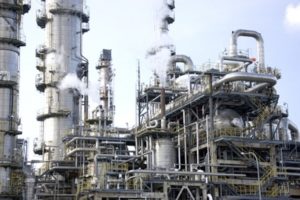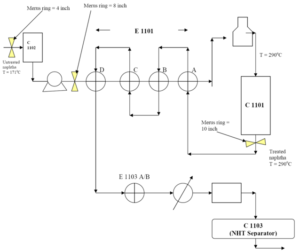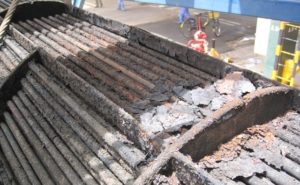Downstream oil and gas industry
Downstream are the refineries and petrochemical plants. This is where the final process steps in the Oil and Gas Industry are happening. During the refining the oil has to be purified and cleaned, especial sulfur and salts has to be removed.
 The next midstream step, the hydrocarbon is broken down into various components. To achieve this, the oil is heated, usual to temperatures of around 400° C. Individual components such as naphta, gasoline are separated at 150°C. Cerosine, jet fuel and petroleum at around 200°C, diesel at 300°C and heavy oils at 375°C. The remaining stuff are lube oils, bitumen, tar, asphaltene, etc.
The next midstream step, the hydrocarbon is broken down into various components. To achieve this, the oil is heated, usual to temperatures of around 400° C. Individual components such as naphta, gasoline are separated at 150°C. Cerosine, jet fuel and petroleum at around 200°C, diesel at 300°C and heavy oils at 375°C. The remaining stuff are lube oils, bitumen, tar, asphaltene, etc.
Essential for the quality of the end products is the quality of the crude oil or the natural gas. Having a light and clean oil, such as the WTI from Texas, the refining is far easier, compared to a high viskose oil full of sulphur and tar. Therefore some oil companies doing the refining at different locations. Some refineries are specialized and produce only light oil, and others produce only lubricating oil.
Heating oil downstream
 As told above in most refineries the crude oil is heated to 400°C. The most efficient way to heat up the product, is a so called heat train. It consist of cross flow heat exchangers and a furnance. The crude is heated step by step and the furnance has not to do all the heating in one step. This is also very energy efficient. This crossflow heat exchanger are an important part of each downstream process.
As told above in most refineries the crude oil is heated to 400°C. The most efficient way to heat up the product, is a so called heat train. It consist of cross flow heat exchangers and a furnance. The crude is heated step by step and the furnance has not to do all the heating in one step. This is also very energy efficient. This crossflow heat exchanger are an important part of each downstream process.
As seen in the flow sheet the untreated naphta enters at already 170°C. The naphta goes straight through the tube side of the four heat exchangers and entering a furnance. There is is heated up to 290°C. Then the naphta goes back through the heat exchangers. This time on the shelfside and so get cooled. At the same the fresh naphta is preheated.
Downstream Merus has two major applications
 We are dealing in the downstream sector with 2 major applications.
We are dealing in the downstream sector with 2 major applications.
There are first the heat trains. Here we improve the fouling in the heat exchangers. We are not always able to stop the fouling, but we achieve for sure to slow down the rate of fouling. All this is documented with data from the heat transfer or the cleaning frequency.
Second Merus treat cooling water in the processes. In a refinery a lot of cooling is requiered. Either we treat the whole cooling system or we treat only certain dedicated machines. Here we fight the normal issue.
Scaling, Corrosion, Biofouling.
Continue reading about upstream or midstream.
